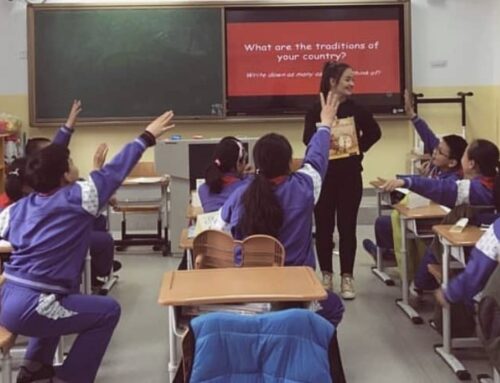‘How would you engage your students?’ – it’s a question you’ll hear in just about every TEFL interview you do, or at least some variation of it. Currently, there is a real emphasis on engaging and enthusiastic teachers. Whilst there are many different ways to make your classroom environment fun, engaging and exciting, having a few quick games up your sleeve will always be helpful. We’re going to share some of the games that we’ve found to be a real hit in the classroom, no matter what age group you’re teaching.
Hangman
A classic crowd pleaser. Teachers and students alike love it. If you don’t know the rules:
- Where have you been?
- The teacher starts by picking a word, and writing a line on the board for each letter. The students take turns guessing which letters might be in the word, whilst every incorrect guess causes them to edge a line closer to the drawing of the ‘hanging man’. If a student guesses the complete word before the drawing is complete, they come to the board and choose a word for the others to guess – it’s that simple!

The main reason for this is that it’s easy to teach the rules of hangman to your class, and everyone can get involved without going to the extent of moving furniture (which can be made into a 20 minute activity if your class is smart enough). If your class has minimal English, around A1 level, teaching complicated and lengthy rules can be time-consuming/nigh on impossible. However; the picture-based game of Hangman allows all levels to access the game, and can be used for almost all age groups. Personally, I’ve used Hangman with ages 10-16, and it’s always been met with cheers of approval and excitement. I like to use it after we’ve covered a lot of related vocabulary, and then the words have to somehow fit the theme we’ve been learning about. Be prepared to step in though, as there are sometimes spelling mistakes which can be corrected and help the whole class remember the correct spelling – a truly fun and educational game, an all-rounder.
Splat
Initially one I had planned for the younger ones, I now use this with ages 5-16 after seeing the usually quiet class of 15 year olds fighting for their life on the splat board. The splat board being any surface that you can write on or stick things on. An example of the game could be something like the following:
surface that you can write on or stick things on. An example of the game could be something like the following:
You’re teaching colours to you A1 students; they’ve just learnt the different words for each colour and you’re trying to consolidate this vocabulary at the end of the lesson. You write/use pictures of each of the colours they’ve learnt so far on a board at the front of the classroom. The class is split into two teams and one representative from each group stands in front of the classroom facing the board – make sure they’re standing at the same line, there’s always one kid that tries to sneak forward! You shout at one of the colours, and the first student to hit that colour with his palm wins the point for his team.
I’m sure you can already see why this is one that requires quite a close eye, as the students can get quite excitable and end up tripping over each other. For my older students, I like to take the whole game up a notch. Firstly, we’ll use more complicated goals, so rather than simply matching the word with its written form or a picture, I might write different word classes on the board, or I might shout a synonym for the word they have to hit. If the students are sensible, I might also try to make it a bit more difficult by having them start further back, so they have to run to the board as well as think about what’s being shouted, but make sure their paths for this are clear!
Hot-seat / Taboo
 I’ve combined these two as I’ve heard quite a few different variations of the rules, which has caused more than one argument in my classes before. Essentially, the games are the inverse of each other. For Taboo, one student sees a word on a card which they then have to describe to their class, without using a set list of related words. That student’s team then wins a point if they guess within your set time period (I normally use 30-60 seconds). For Hot-seat, the whole team sees the word they need to describe, apart from one student. The team then needs to describe the word to the student in the ‘hot-seat’.
I’ve combined these two as I’ve heard quite a few different variations of the rules, which has caused more than one argument in my classes before. Essentially, the games are the inverse of each other. For Taboo, one student sees a word on a card which they then have to describe to their class, without using a set list of related words. That student’s team then wins a point if they guess within your set time period (I normally use 30-60 seconds). For Hot-seat, the whole team sees the word they need to describe, apart from one student. The team then needs to describe the word to the student in the ‘hot-seat’.
This is a good game for consolidation of learning at the end of a lesson or unit, rather than starting a lesson. This is simply because it requires quick retrieval which is more effective once they’ve gotten into the swing of the lesson. Not only does it practise their retrieval, it also helps form strong bonds between your students. With both versions, they have to learn what works well when describing to different classmates, as well working together against the clock. I’ve found this game works best with ages 10-14, as the older ones get a little more self-conscious about being the odd one out and having the pressure of the win on their shoulders.
Last-minute interview tips
As a bonus-tip for your interview, they’ll probably ask you when you would use a game in a lesson – do you know what to say? I always say that it’s a great starter to get the students thinking in their target language, or as a plenary to really consolidate their learning of new vocabulary, grammatical rules, or whatever else they’ve been learning – hope that helps!
These are just 3 of about 3 million different games you could choose to play in your classroom. Some of my other favourites include Bingo, ice-breaking games or Pictionary, but we’d be here all day if I listed out all the different games I’ve tried so far – it’s a lot of trial and error to find out what works for you and your class. If you’ve had a chance to try out any of these games, or tried any other good ones, let us know how they went in the comments, we might just steal them for our own classrooms…
Ready to head over to your dream ESL destination? Explore our programs in Vietnam, Thailand, China, Cambodia or Poland or send in an application.
About the author





